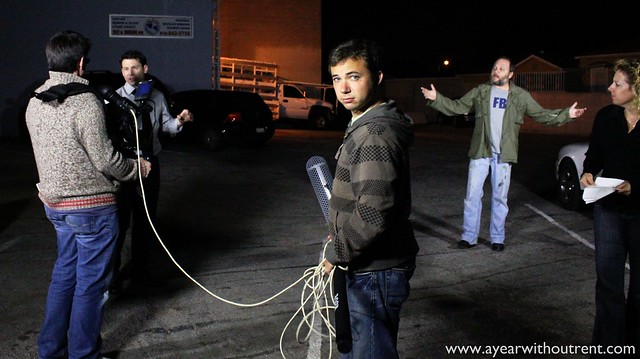
I've never worked in front of a green screen before, so when Sean Gillane tells me that his film CXL (stands for cancel) is going to involve some VFX green screen work, I'm pretty excited. Maybe intrigued is the better word.
We're shooting at the [name] in San Francisco, CA, which conveniently is where Sean works. The crew for this film is super small--probably the smallest yet on A Year Without Rent. Sean is directing and running the camera himself. Beyond that there's a team of three VFX guys with some lighting/grip experience, a producer/sound person (Katherine Bruens), and me. Oh, and the cast.

I guess in my head, I thought shooting on a green screen would go faster than shooting in real life. You're in an enclosed space with no variables, and all you need to do is film the live-action portions. Not so much. Lighting is almost harder in a way. When you're shooting outside, there's shadows all over the place and a lot of them disappear into other stuff, but it's a major concern how the actor's shadow plays out across the green. Is it harsh enough? Too harsh? How well will they be able to key around it or with it? And, more importantly, how will that shadow then interact with the world they're building under it?

Add to that the fact that the light needs to be as evenly distributed across the background as possible, and the need for tracking marks that the actor won't cross in front of, and it can all add up pretty quickly.
It's complicated stuff, and involves a lot of huddling by the VFX people to figure things out. Essentially, what ends up happening is two things: 1) Sean blocks the scene and lights it for what he needs narratively. 2) The VFX people then try and re-light the scene without changing Sean's lighting, so that they can most effectively do the post work.
When you look at it that way, it's kind of time-consuming.
It's also pretty obvious why actors aren't big fans of this sort of thing. Cole [name] spends a lot of his time interacting with a post-it note, which isn't exactly the sort of thing people think of when they become actors, I imagine.

But all of that is a prelude to Sean's goal of pulling off a forced perspective shot, which is a tricky enough thing to do in the real world. Will it work? I hope so. Usually I can tell pretty easily if a scene is going to work, if it'll cut together, but here I have no idea. It certainly could work. Hell, it probably will work. But I just have no idea whatsoever.
After that, it's across the street to shoot something in an alley. Only, with a crew this small (even smaller, since 2 of the VFX guys have left), I volunteer to guard the grip cart that has lots of expensive stuff on it. Seems like something we shouldn't leave unattended on the streets of a major city.


Filmmaker Lucas McNelly is spending a year on the road, volunteering on indie film projects around the country, documenting the process and the exploring the idea of a mobile creative professional. You can see more from A Year Without Rent at the webpage. His feature-length debut is now available to rent on VOD. Follow him on Twitter: @lmcnelly.
















































